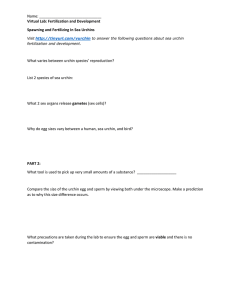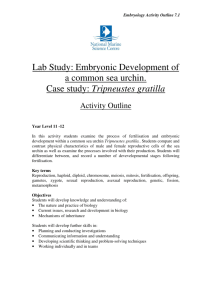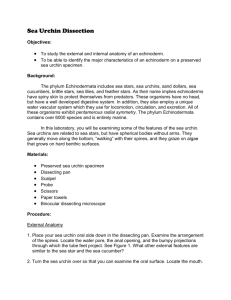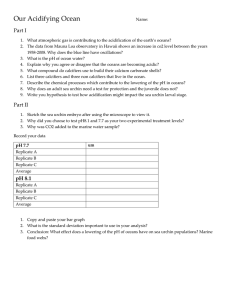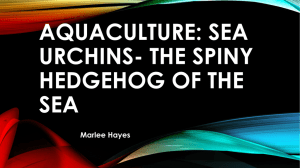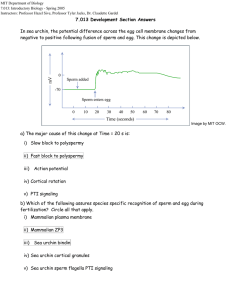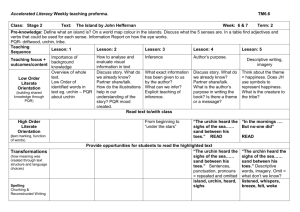AN ECONOMIC ASSESSMENT OF SEA URCHIN (TRIPNEUSTES GRATILLA) CULTURE
advertisement
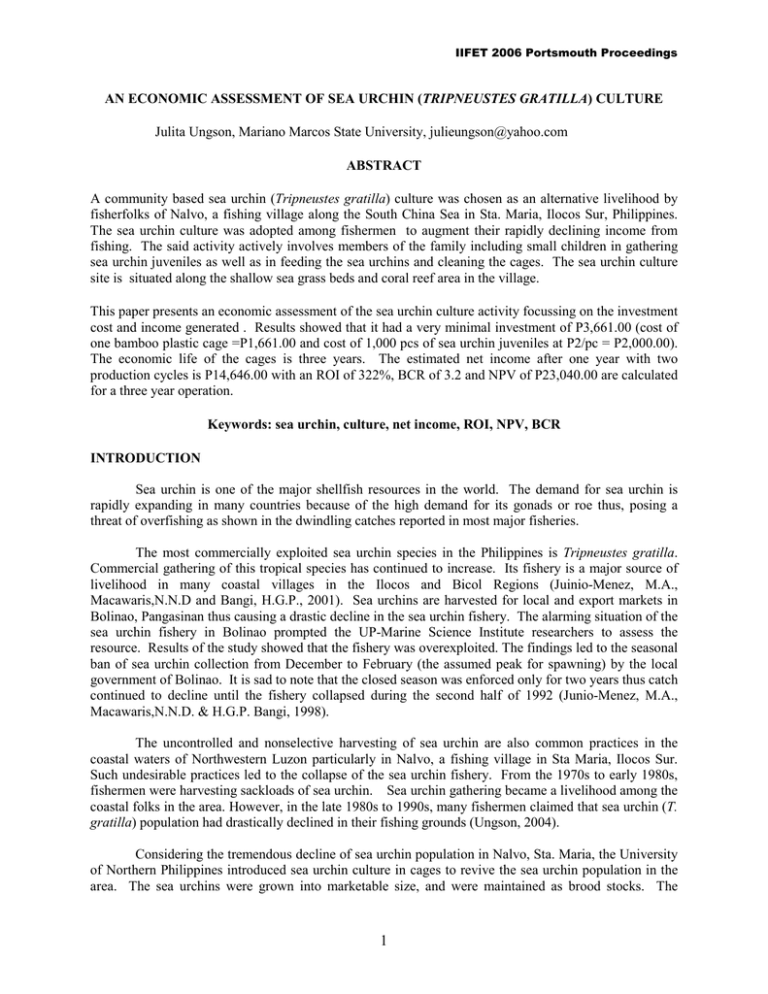
IIFET 2006 Portsmouth Proceedings AN ECONOMIC ASSESSMENT OF SEA URCHIN (TRIPNEUSTES GRATILLA) CULTURE Julita Ungson, Mariano Marcos State University, julieungson@yahoo.com ABSTRACT A community based sea urchin (Tripneustes gratilla) culture was chosen as an alternative livelihood by fisherfolks of Nalvo, a fishing village along the South China Sea in Sta. Maria, Ilocos Sur, Philippines. The sea urchin culture was adopted among fishermen to augment their rapidly declining income from fishing. The said activity actively involves members of the family including small children in gathering sea urchin juveniles as well as in feeding the sea urchins and cleaning the cages. The sea urchin culture site is situated along the shallow sea grass beds and coral reef area in the village. This paper presents an economic assessment of the sea urchin culture activity focussing on the investment cost and income generated . Results showed that it had a very minimal investment of P3,661.00 (cost of one bamboo plastic cage =P1,661.00 and cost of 1,000 pcs of sea urchin juveniles at P2/pc = P2,000.00). The economic life of the cages is three years. The estimated net income after one year with two production cycles is P14,646.00 with an ROI of 322%, BCR of 3.2 and NPV of P23,040.00 are calculated for a three year operation. Keywords: sea urchin, culture, net income, ROI, NPV, BCR INTRODUCTION Sea urchin is one of the major shellfish resources in the world. The demand for sea urchin is rapidly expanding in many countries because of the high demand for its gonads or roe thus, posing a threat of overfishing as shown in the dwindling catches reported in most major fisheries. The most commercially exploited sea urchin species in the Philippines is Tripneustes gratilla. Commercial gathering of this tropical species has continued to increase. Its fishery is a major source of livelihood in many coastal villages in the Ilocos and Bicol Regions (Juinio-Menez, M.A., Macawaris,N.N.D and Bangi, H.G.P., 2001). Sea urchins are harvested for local and export markets in Bolinao, Pangasinan thus causing a drastic decline in the sea urchin fishery. The alarming situation of the sea urchin fishery in Bolinao prompted the UP-Marine Science Institute researchers to assess the resource. Results of the study showed that the fishery was overexploited. The findings led to the seasonal ban of sea urchin collection from December to February (the assumed peak for spawning) by the local government of Bolinao. It is sad to note that the closed season was enforced only for two years thus catch continued to decline until the fishery collapsed during the second half of 1992 (Junio-Menez, M.A., Macawaris,N.N.D. & H.G.P. Bangi, 1998). The uncontrolled and nonselective harvesting of sea urchin are also common practices in the coastal waters of Northwestern Luzon particularly in Nalvo, a fishing village in Sta Maria, Ilocos Sur. Such undesirable practices led to the collapse of the sea urchin fishery. From the 1970s to early 1980s, fishermen were harvesting sackloads of sea urchin. Sea urchin gathering became a livelihood among the coastal folks in the area. However, in the late 1980s to 1990s, many fishermen claimed that sea urchin (T. gratilla) population had drastically declined in their fishing grounds (Ungson, 2004). Considering the tremendous decline of sea urchin population in Nalvo, Sta. Maria, the University of Northern Philippines introduced sea urchin culture in cages to revive the sea urchin population in the area. The sea urchins were grown into marketable size, and were maintained as brood stocks. The 1 IIFET 2006 Portsmouth Proceedings maintenance of brood stocks in submerged cages in the coastal waters of the said fishing village had substantially increased the sea urchin population. This ultimately led to the development of the sea urchin culture in the village. Preliminary grow out culture of sea urchin started in 1986 with 11 fisher families from the village, led by the barangay captain. The culture area was in front of the village on the subtidal portion (2m in depth) of the rocky – rubble reef flat which was covered with seaweeds, Sargassum (JuinioMenez, M.A., M.C.D Malay and H.G.P. Bangi, 1993). Sea urchin culture started with one cage and then increased to 2-5 cages per fishermen. At present, some fishermen own 4-12 cages, each. (Ungson, 2004). In Nalvo, sea urchins are sold whole in the local market, with the larger getting the better price, thus, only the biggest urchins are harvested (Juinio-Menez, M.A., M.C.D Malay and H.G.P. Bangi, 2001). Sea urchin roe is considered a delicacy among local people. According to Ungson (2004), most of the sea urchin culturists had considered culturing sea urchin as their major source of income rather than fishing. The sea urchin culture had decreased the fishing pressure exerted in a heavily exploited fishery. The sea urchin culturists organized an association, the Nalvo Sea Urchin Culture Association with more than 90 members. The said association now plays an important role in the harvesting and price regulation of sea urchin. CULTURE AREA The sea urchin culture site is located in the shallow waters of a fishing village in Nalvo, Sta. Maria, Ilocos Sur (120010’E, 17020’N) which is situated in Northwestern Luzon, Philippines (See Figure 1). Nalvo has a population of about 3,000. Fishing is the main livelihood of the people. There are about 328 fishing households and they fish several kilometers away from the fishing village. As per interview with the fishermen in the area, their income due to the rapidly declining fish catch could hardly provide the basic needs of their family. 2 IIFET 2006 Portsmouth Proceedings The severe decline of fish catch among fishermen in the village prompted them to shift their attention to the culture of sea urchin. At present, about 95% of the fishing households in Nalvo are now engaged in the culture of sea urchin. Some of the fishermen had shifted to become full-time sea urchin culturists because sea urchin culture is easier, more profitable, and less risky, compared to fishing. SEA URCHIN CULTURE The culture of sea urchin in Nalvo makes use of bamboo cages or net cages that are locally available in the area. The common cage used by culturists is the bamboo cage with a size of 6m x 6m x 0.6m. The cage is submerged in the shallow coastal waters as shown in Fig. 2. The cage is tied with a plastic rope in rocky substrate or an iron bar imbedded in the seabed. Figure 2. Sea urchin bamboo cages during high and low tide in Nalvo, Sta. Maria, Ilocos Sur, Philippines The sea urchin juveniles that reach the size of 1-2 cm are gathered by culturists, namely the fishermen and family members. Gathering of juveniles is done along the sea grass beds that are within the vicinity of the sea urchin culture cages in Nalvo. Even elementary school children are involved in gathering sea urchin juveniles which they sell to culturists at P1-P2 per juvenile, depending on the size. The juveniles are put in submerged cages with a density of 1,000 pcs per cage with a size of 6m x 6m x 0.6m. The juveniles are fed with seaweeds (Sargassum) gathered within the vicinity of the culture area. A 30-minute collection of seaweeds by one person is enough to feed the sea urchins of six cages. The culture of sea urchin juveniles takes about five months for the juveniles to reach marketable size. The sea urchins are harvested and sold to the market at P80 per kilo fresh weight. Some buyers directly go to the culture site to buy sea urchin. METHODOLOGY The economic estimation of the benefits derived from sea urchin culture in Nalvo is based on the following assumptions: 3 IIFET 2006 Portsmouth Proceedings • • • • • • • • • • • • • No loan is incurred based on the interview of sea urchin culturists. The cost of bamboo cages is affordable due to the use of locally available materials. The economic life of bamboo cages is three years. Bamboo cage is depreciated using the straight-line method with a zero salvage value. Survival rate from juveniles to marketable size is 96%. Discount rate is 15%. The cost and benefit estimation is for three years since the economic life of the bamboo cage is also three years. There are two production cycles per year in the culture of sea urchin. One production cycle is five months. One kilo of marketable sized sea urchin has an average of eight pieces. Price per kilo of sea urchin is P80(US$1.51). There is no feed cost because feeds used are the collected seaweeds (Sargassum) within the culture sites. There is no labor cost because it is provided for free by the fisherfolk and their family members. A 30-minute collection of seaweeds by one person is enough to feed six cages of sea urchin per day. All costs and prices are in Philippine peso. One US dollar equals 53 Philippine pesos. The economic tools used are return on investment (ROI), net present value (NPV) and benefit cost ratio (BCR). The net income is also calculated. ROI is computed by dividing the net income by the total investment. NPV is computed by taking the difference between the present value of the return stream and the present value of the cost stream. BCR is obtained by dividing the present value of the return stream with the present value of the cost stream. The discount rate used for both the NPV and BCR is 15%. Net income is derived by deducting the total cost of production from the gross sales. Cost data incurred in the culture of sea urchin and the estimated income from the activity were provided by the sea urchin culturists in the area. RESULTS The results of the economic analysis are presented in Tables 1-3. Table 1 shows the cost of a bamboo cage that is considered as a major capital investment in the culture of sea urchin in Nalvo. The total investment cost of one 6m x 6m x 0.6m bamboo cage is P1,661.00 (US$31.34). The estimated economic life of the cage is three years with an annual depreciation cost of P554 (US$10.54). The minimal investment cost of a bamboo cage is affordable for ordinary fishermen in the area. The use of materials readily available in the locality makes it very convenient for the fishermen. Presently, some sea urchin culturists own 4-12 cages. Based on the interview among culturists, they are capable of putting up cages without incurring any loan. The sea urchin juveniles in the vicinity are collected by family members and put in cages and grown to marketable size for five months. 4 IIFET 2006 Portsmouth Proceedings Table 1. Investment cost of a bamboo cage for sea urchin culture in Nalvo, Sta. Maria, Ilocos Sur, Philippines Item Bamboo Plastic screen Nylon Labor Miscellaneous Qty 8 6 1 3 Unit pcs m kl man-days Cost/Unit P30 P70 P250 P200 Total • • Total cost P240 P420 P250 P600 P151 P1,661 Economic life = 3 years Depreciation cost/year = P554 The stocking density of sea urchin juveniles in a 6m x 6m x 0.6m cage is 1,000 pcs. Survival rate in a five-month culture period is 96%, thus, of the 1,000 pcs stocked in a cage, about 960 pcs will be able to grow to marketable size with 6-10 pcs a kilo. It is estimated that about 120 kilos of marketable sea urchin will be harvested from one cage within five months. The cost and return of sea urchin culture in Nalvo, Sta Maria is presented in Table 2. The prevailing price of sea urchin per kilo in the area is P80 (US$1.51), thus a total sales of P9,600.00 (US$181.13) for one cage in a five-month culture and a total sales of P19,200.00 (US$362.26) in a year is generated with a net annual income of P14,646.00(US$276.34). Thus, if a sea urchin culturist has 12 cages, his total net income in a year is P175,752.00 (US$3,316.08) which is considered very high for a small-scale fisherman’s income, the standard of which is P150.00/day (US$2.83) in the Philippines, as reported by the NWPC (2005). Table 2. Cost and return of sea urchin culture per bamboo cage (6m x 6m x 0.6m) in a one-year culture period* Sales of sea urchin at P80/kl Less: Depreciation cost Cost of juveniles at P2/juvenile Feed Labor Total cost Net Income P19,200.00 P554.00 P4,000.00 P4,554.00 P14,646.00 *Two production cycles in a year (5 mos. culture period per production cycle) The high income generated from the activity is attributed to the low cost of producing marketable sea urchin. Feed and labor costs are free considering that the feeds (seaweeds) are just collected within the area of culture and the labor is provided by members of the family. A daily 30-minute collection of seaweeds within the culture area is enough to feed six cages of sea urchin. The feeding of sea urchins and the cleaning of cages can be done by one person. The regular price of P80/kl of marketable sea urchin is acceptable. During peak season, the price of sea urchin per kilo may even go up to P150. 5 IIFET 2006 Portsmouth Proceedings Table 3 shows the computed ROI of 322%, NPV of P23,040 and BCR of 3.2. The figures show that sea urchin culture is an economically feasible investment and could be recommended as an alternative livelihood for fishermen in other coastal areas in the Philippines where sea urchin culture is technically and economically feasible, considering the low capital investment and high economic return. Table 3. Economic benefit estimation tools of sea urchin culture for three years in Nalvo, Sta Maria, Ilocos Sur, Philippines Economic tools* Computed ROI NPV BCR 322% P23,040 3.2 *The estimation was done for one bamboo cage for three years. POLICY RECOMMENDATION Considering the severe decline of catch in almost all coastal fishing villages in the Philippines of which Nalvo is no exception, it is recommended that one option to increase the income of fishermen is to venture into an alternative livelihood like sea urchin culture. This was proven successful in Nalvo and it can be replicated in other coastal areas where sea urchin culture is feasible. However, an effective extension program should be provided to transfer the technology to other coastal communities. An effective marketing strategy should be adopted so as not to oversupply the local market and result in affecting the price and ultimately making sea urchin culture not economically feasible. The export market and specialty restaurants should be targeted as potential buyers, thus, a need for the sea urchin culturists to organize themselves into a functional and effective association that will venture the marketing of their products. A holistic research program that will look into the culture of sea urchin, processing, packaging and marketing should be conducted to ensure the sustainability of the sea urchin industry. Although sea urchin culture is a very promising fishery management strategy, the potential impact on the local environment has to be studied (Malay, et al. 2000). There is a need to institute a legal framework for best practices in sea urchin culture for it to be environment friendly and economically sustainable. CONCLUSION The sea urchin culture has proven to be a great success in Nalvo in providing an alternative livelihood among fishermen. Today, it has become a model for the establishment of similar projects in other coastal villages in neighboring towns and provinces in Northern Luzon. The successful adoption of this technology in other coastal areas can be used as a management fishery tool of decreasing fishing pressure in a heavily exploited fishery by shifting the effort of fishermen from a destructive practice of extracting fishery resources (the use of dynamite and toxic substances) to a nondestructive practice such as culturing sea urchin. The sea urchin culturists will have to protect their environs and act as stewards in the protection of the coastal area from any illegal fishing and poaching activities. 6 IIFET 2006 Portsmouth Proceedings REFERENCES Juinio-Menes, M. A. Macawaris, N. and Bangi, H. 1993. Potentials of sea urchin culture as a resource management strategy. In Philippine Coastal Resources Under Stress. M.A. Juinio-Menez & G.F. Newkirk (eds.) Selected papers from the Fourth Annual Common Property Conference held in Manila, Philippines, 7 pp. Juinio-Menes, M.A. Macawaris, N.N.D. and Bangi, H.G.P. 1998. Community based sea urchin (Tripneustes gratilla) grow out culture as a resource management tool. In Proceedings of the North Pacific Symposium on Invertebrate Stock Assessment and Management. G.S. Janilso and A. Campbell (eds.) Can. Spec. Publ. Fish. Aquat. Sci. 125. pp. 393-399. Malay, MCF, Bangi, HG and Juinio-Menez, MA. 2000. Enhancement effect of sea urchin grow-out cages in Lucero, Bolinao, Pangasinan. Science Diliman (July-Dec. 2000) 12:2, 1-9. Juinio-Menes, M.A. Macawaris, N.N.D. and Bangi, H.G.P, 2001. Sea urchin grow out culture. Coastal Resources Management Tools. Marine Environment Resources Foundation, Inc. The Marine Science Institute, University of the Philippines, Diliman, Q.C. 34 p. NWPC, 2005. Rules Implementing Wage Order No. RB 1-10 Regional Tripartite Wages and Productivity Board-I, DOLE, San Fernando, La Union. Ungson, J. 2004. Stock enhancement of sea urchin (Tripneustes gratilla) in Northwestern Luzon, Philippines: A Management Strategy. In IIFET 2004 Japan Proceedings. Tokyo, 10 pp. ACKNOWLEDGEMENT The author wishes to thank Dr. Arsenia Domingo, Dean of the College of Arts and Sciences of the University of Northern Philippines and her husband, Mr. Jess Domingo, barangay chairman of Nalvo, who were very accommodating and who facilitated the author’s interview with the sea urchin culturists. Thanks are also due the MMSU administration and staff of MMSU - CASAT, Ms. Carol Pascual who helped in the preparation of the manuscript. 7
